How a Gene Variant Raises the Risk of Multiple Sclerosis
Now that sequencing the whole human genome is easier, faster, and cheaper than it used to be, scientists have been able to gather large amounts of genetic sequence data for thousands of individuals. That has helped scientists link small changes in the genome to a greater likelihood of certain diseases or characteristics.
Multiple sclerosis is a chronic, autoimmune disease with variable presentation. It can cause fatigue or disrupt movement among many other symptoms. It seems to be caused by a complex interplay of genetics and environmental factors. There is a genetic variation associated with a cluster of genes called the human leukocyte antigen (HLA) complex, and this variant, HLA-DR15, is known to be linked to a higher risk of disease. Researchers know that about half of MS patients carry the HLA-DR15 gene variant. Researchers have now learned more about how they are linked; their findings were reported in Cell.
When people that carry HLA-DR15 get infected by the Epstein-Barr virus, their risk of developing MS goes up 15 fold.
"There are therefore clear indications that the interaction between HLA-DR15 and infectious agents such as Epstein-Barr virus is significant for the development of the disease, even though the exact mechanisms behind this have not been understood until now," said UZH Professor Roland Martin, Head of the Department of Neuroimmunology and MS Research at the University Hospital Zurich.
An international team led by Martin has now found that in people with the HLA-DR15 variant, their immune systems have a keen ability to identify certain pathogens, including the one that causes Epstein-Barr, but when immune cells move to attack it, they can also attack healthy brain tissue.
One place immune antigens or HLAs like HLA-DR15 are found is on the surface of white blood cells, so they can present pieces of microbes to T lymphocytes in the immune system. T lymphocytes are involved in the immune response, in which cells are trained to leave cells in the body alone, but attack pathogenic invaders. Immune cells ‘learn’ to differentiate between cells of the self and invaders in the thymus first, and then they move to the blood where they can surveil for pathogens.
In people with the HLA-DR15 variant, the researchers found that in the thymus, these HLA-DR15 molecules on white blood cells are mostly presenting pieces of themselves. T lymphocytes that learn this move into the blood, and can rapidly identify the Epstein-Barr virus if it enters the body. These viral fragments are hyper activating compared to the HLA-DR15 fragments.
The T lymphocytes can stop the virus, but they can also move to the brain and start reacting with the proteins of the self, causing an autoimmune response. Epstein-Barr is the biggest risk factor for MS, and nearly all MS patients have the virus.
"The most important genetic risk factor for MS, therefore, shapes a repertoire of T lymphocytes that responds very well to certain infectious agents such as Epstein-Barr virus and intestinal bacteria," said Martin. While the immune system can do good work, it can also overdo it and cause problems.
"The disadvantage of this fitness is therefore that those affected also become susceptible to an immune response against their own brain tissue, which can lead to multiple sclerosis," added Martin.
"Our work has shed light on mechanisms that are likely to play a role in a number of other autoimmune diseases. In addition to improving our understanding of underlying causes of the disease, this could also lead to the development of new treatments.”
Sources: AAAS/Eurekalert! via University of Zurich, Cell









